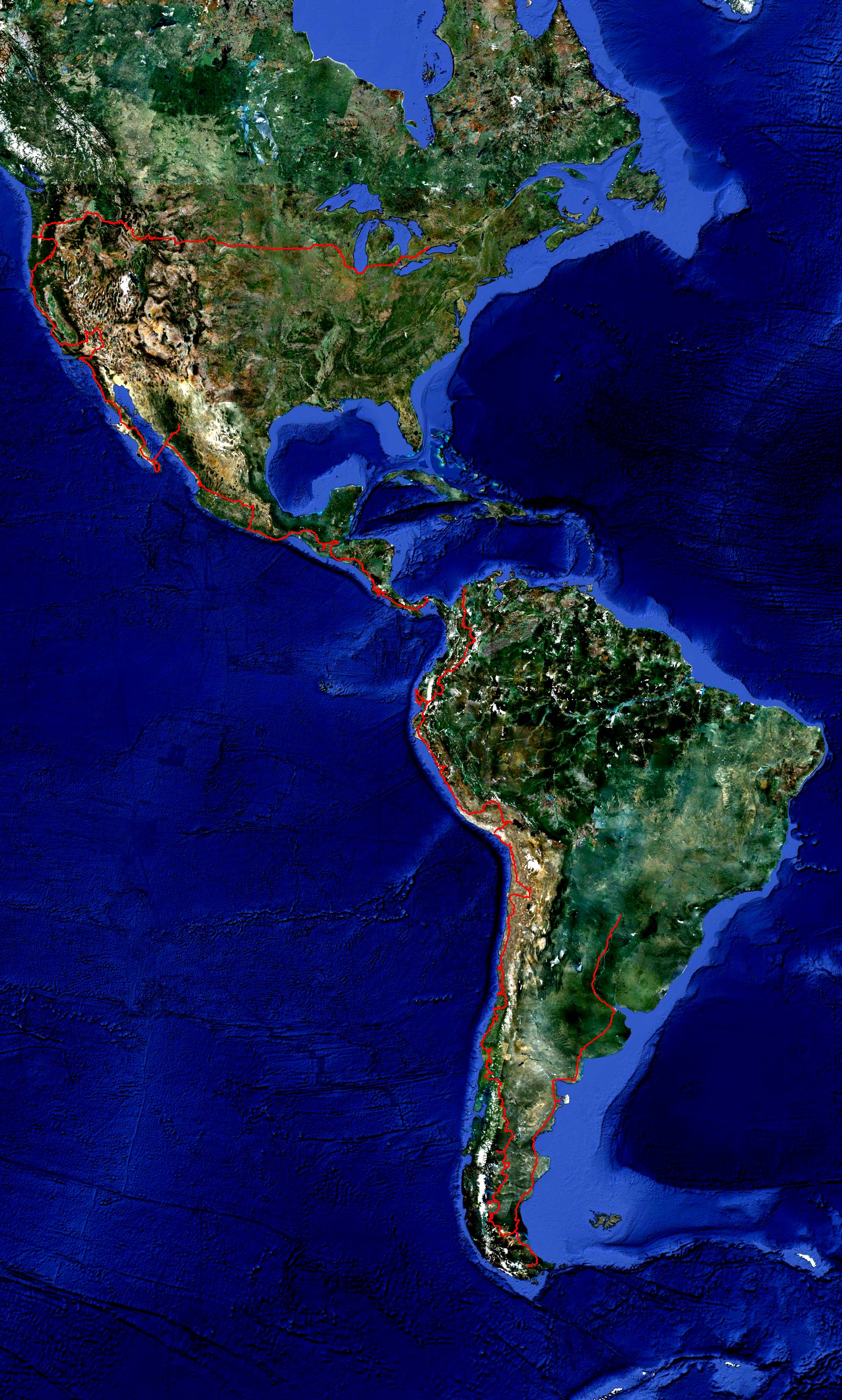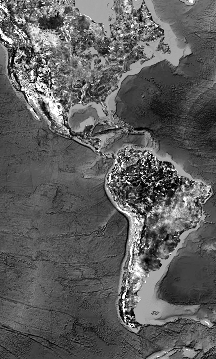Peru’s entire Pacific coastline is a shifting mix of arid and semi-arid dunes, but just south of the Peru-Chile border at about 18 degrees south is the heart of this arid coast – the Atamaca Desert, apparently the driest in the world. After spending the last night in Peru on a spectacular campsite overlooking a huge desert valley (called a cuesta) we cruised south towards the Chilean border.
At first sight, the Chilean border looked like the most civilized we had seen since USA-Mexico. The setup looked like a big toll plaza where vehicles wait in lineups to come up to the window and get searched (I know this may sound like the logical way to do it, but trust us that most of Latin America doesn’t look this way).
Surprise! We are still in Latin America: what in fact happens is that you line up your vehicle, then get out and go wait in a huge lineup for immigration. When you get back to your vehicle, you are stuck in a gridlock of parked cars with some owners back in their vehicles but gridlocked in, and everyone waiting for those blocking them to get back so that they can drive up to the inspection area. After inspection you also have to walk to a trailer hidden in a corner that no one tells you about to get another stamp.
This was the first border where the officials were doing thorough vehicle checks, and everyone was required to pull absolutely everything out of their cars and put it through an x-ray machine. Since our car was full of miscellanous individual items (i.e. bikes, wheels, water tanks, boxes of gear, surfboards, etc…) this was going to be extremely inconvenient. Fortunately, they agreed to just bring a dog in to sniff all our stuff at the car, but did find all our fruits and vegetables. There went our imported Jesterfield Canadian honey (from Jono’s house) and a large part of the food we had spent hours buying at the market in Puno. At least we managed to eat the watermelon while waiting in the immigration lineup.
To make things better, the girls decided to listen to music and charge laptops while Jono and I did paperwork. This led to the embarassing situation of needing a jump start in the middle of the vehicle importation process.
Once in Peru, the going was smooth. We cruised along highway 5 (it’s cool that Interstate 5 is also the main north-south route on the west coast of the USA) through dry desert. The distances here in Chile are formidable. From the border, it was 2000km to Santiago, 1400km past that to the end of highway 5 in Puerto Montt, and 1200km of dirt after that to the end of the Carretera Austral in Puerto O’Higgins. After that Chile becomes thousands of kilometres of impassable fyords and ice fields. Anyway for the time being we were still far from the ice fields in arid heat and sand.
We cruised through nothingness, stopping in the middle of the desert to camp the first night.
Along the way there were few towns, with gas stations having hundreds of kilometers in between. Some ancient peoples did live here and left all sorts of geoglyphs on the hills that are only somewhat impressive. The dark patch on the mountain in the middle of this photo is one of them…
…as is the rectangle-headed dude with the posture Ewa is demonstrating in the background…
The scale of the beautiful rugged desert scenery was often overwhelming, especially on the coast…
The only city of interest we passed in the north was Iquique, a substantial city right on the coast where we stopped for some delicious fried fish in the central market.
Chileans are people who love vacations, the outdoors, and family camping trips. January and February being their summer, it seemed that everyone was out camping on the beaches, mountains, and basically all over the country. In Chile it is acceptable to camp pretty much anywhere, usually bringing a convoy of vehicles, the entire extended family, at least a few massive tents, and all the toys. We decided to do the same and seek out our own spots along the rugged coastline…
The girls wrote Safari Americano in the sand with seashells!
After a couple days on the coast, we decided to cruise inland to the edge of the desert where it meets the mountains and where there are geysers and hot springs. We cruised for a few hours along well-maintained dirt roads through the desert, seeing the mountains approach on the horizon.
Then, at one point, we were climbing a hill, and I noticed the Safari going slower and slower. 40km/h… 35km/h… 30km/h…. and I had the pedal to the floor. I forced it into 1st gear and slowly crawled to the peak of the ridge. Some of us had been complaining that the Safari cabin was smelling of gasoline fumes for the past couple hours, and now everyone agreed they smelled it. We were hundreds of kilometres from any pavement, let alone any town, in the semi-arid foothills of the Andes. Once stopped, we saw that radiator fluid was leaking out under the car, and under the hood we pinpointed the leak at one of the joints. In addition, the turn signals had just mysteriously stopped working. We asked this vicuna if it could help but it wasn’t familiar with our model of Chevrolet.
The radiotor leak was slow, and there was still lots of coolant. The turn signals weren’t really needed to get us off this remote dirt road either. The main question was why we had no power in the engine. We played around with it for a while and found that gas getting to the engine alright, and we found no leaks. It turned out that the smell of gas seemed to be coming from a pop bottle full of gasoline we were keeping in the back of the car which we used for our cooking stove.
Then, someone turned on the GPS and the altimeter gave it away – we had again managed to get ourselves to 4000m above sea level. That explained the low power in the non-turbocharged Safari, so we hopped back in and kept crawling to the hot springs.
When we got to the springs, it was raining, and everyone was again suffering from altitude sickness and indigestion. We decided to camp out nearby and wait for the promised sunshine the next morning…
The setting was beautiful with snow-covered mountains in the distance, but the geysers were decidedly less impressive than the ones at Yellowstone (USA) and the thin air made hanging out in the hot springs a bit less enjoyable. After getting our fill of chillin in the hot water, we headed downhill into the desert to check out the salt flats. The Salar de Atacama had a rugged broken up surface…
…while others were a lot flatter like the salt flats we expected…
We also took full advantage of the flat driving surface the flatter salt flats afforded…
…and then found a sweet camping spot on a little salt flat among the hills…
We decided we were done with the desert at this point. The only problem being that there was still 1500km of it separating us from the cities of Santiago and Valparaiso in the centre of the country. With the Safari on cruise control, we took the Panamerican south.
Stopping at a small town for a meal in a restaurant we quickly noticed that we were now in a country with a bit more of a European heritage. Before your food comes at most restaurants you get a basket of bread and pebre, which is essentially a slightly spicier version of an italian bruschetta . Beer on tap is called schop (like in German) and is served in pitchers (remember to read that with a Spanish accent).
This Schopdog chain of bars serving draft beer and various American-German inspired foods (i.e. burgers with saurkraut, sausages served with guacamole) is to be found on the quiet clean streets of many small Chilean towns. You can also sit down and drink legitimate coffee at European-style patios. An absence of shoe-shine boys, stray dogs, loud kids, and basically people and noise distinguishes these Chilean towns from the Latin American ones farther north.
On our last day of desert driving, the scenery started to change. First, irrigated orchards in the desert valleys, and more scrub on the hills. Soon enough there were vinyards. First those producing pisco (the local brandy), then those of Chile’s more famous wine growing areas. The highwas became a beautiful (in terms of engineering) divided expressway with signage stolen straight from Germany (as well as the license plate style). On this nice road we cruised into Chile’s biggest port city: Valparaiso











































































































More fun times to read about! Love the salt flats vid..LOL!